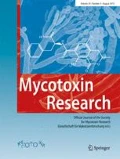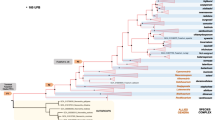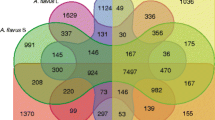Abstract
WhyAspergillus species produce aflatoxin remains an unsolved question. In this report we suggest that evolution of the aflatoxin biosynthesis gene cluster has been a multistep process. More than 300 million years ago a primordial cluster of genes allowed production of anthraquinones that may have served as insect attractants to facilitate spore dispersal. Later adaptive evolutionary steps introduced genes into the cluster that encoded enzymes associated with fungal virulence. These genes may have allowed the otherwise saprophytic fungi to be better able to colonize living plants. Later, genes for production of aflatoxins B1 and G1 were added to the basal cluster. Loss of the ability to produce aflatoxin G1 occurred with the divergence ofA. flavus, a species that, perhaps, was more successful than its ancestors at colonizing plants. This logical progression in evolutionary development of the aflatoxin biosynthetic cluster fits the phylogenetic data as well as known chemical reactivity of the initially formed anthraquinone polyketide metabolites.
Similar content being viewed by others
References
Bu'lock JD (1965) Biosynthesis of natural products: An introduction to secondary metabolism. McGraw-Hill, London, 1–149
Bhatnagar D, Ehrlich KC, Cleveland TE (2003) Molecular genetic analysis and regulation of aflatoxin biosynthesis. Appl Microbiol Biotechnol 61: 83–93
Bhatnagar D, Ehrlich KC, Chang PK (2000) Mycotoxins. Encyclopedia of Life Scjences, vol. 12. Nature Publishing Company, London, 564–573
Lillehoj EB (1991) Aflatoxin: an ecologically elicited genetic/activation signal. In: Smith JE, Henderson RS (eds), Mycotoxins and Animal Foods. CRC Press, Boca Raton, 2–30
Pringle A, Taylor J (2002) The fitness of filamentous fungi. Trends Microbiol 10: 474–481
Wilkinson H, Ramaswamy A, Sim SC, Keller NP (2004) Inereased conidiation associated with progression along the sterigmatocystin biosyn thetic pathway. Mycologia 96: 1190–1198
Dowd PI (1998) Involvement of arthropods in the establishment of mycotoxigenic fungi under field conditions. In: Sinha KK, Bhatnagar D (eds), Mycotoxins in Agriculture and Food Safety. Marcel Dekker, New York, 307–350
Brown DW, Yu JH, Kelkar HS, Fernandes M, Nesbitt TC, Keller NP, Adams TH, Leonard TJ (1996) Twenty-five coregulated transcripts de-fine a sterigmatocystin gene cluster inAspergillus nidulans. Proc Natl Acad Sci USA 93: 1418–22
Cary JW, Klich MA, Beltz SB (2005) Characterization of aflatoxin-producing fungi outside ofAspergillus section Flavi. Mycologia 97: 425–432
Bradshaw RE, Bhatnagar D, Ganley RJ, Gillman CJ, Monahan BJ, Seconi JM (2002)Dothistroma pini, a forest pathogen, contains homologs of aflatoxin biosynthetic pathway genes. Appl Environ Microbiol 68: 2885–2892
Peterson SW (1997) Phylogenetic relationships inAspergillus based on rDNA sequence analysis. In: Samson RA, Pitt JI (eds), Classification ofPenicillium andAspergillus: Integration of Modern Taxonomic Methods. Harwood Publishers, Reading, 323–356
Graziani S, Vasnier C, Daboussi MJ (2004) Novel polyketide synthase fromNectria haematococca. Appl Environ Microbiol 70: 2984–2988
Linnemannstons P, Schulte J, del Mar Prado M, Proctor RH, Avalos J, Tudzynski B (2002) The polyketide synthase gene pks4 fromGibberella fujikuroi encodes a key enzyme in the biosynthesis of the red pigment bikaverin. Fungal Genet Biol 37: 134–148
Berbee ML, Taylor JW (2001) Fungal molecular evolution: gene trees and geologic time. In: McLaughlin DJ, McLaughlin E, Lemke PA (eds) The Mycota, Springer, Berlin, 229–246
Heckman DS, Geiser DM, Eidell BR, Stauffer RL, Kardos NL, Hedges SB (2001) Molecular evidence for the early colonization of land by fungi and plants. Science 293: 1129–1133
Kasuga T, White TJ, Taylor JW (2002) Estimation of nucleotide substitution rates in eurotiomycete fungi. Mol Biol Evol 19: 2318–2324
Foster PL (2000) Adaptive mutation: implications for evolution. Bioessays 22: 1067–1074
Henson JM, Butler MJ, Day AW (1999) The dark side of the mycelium: melanins of phytopathogenic fungi. Annu Rev Phytopathol 37: 447–471
Inagaki A, Takano Y, Kubo Y, Mise K, Furusawa A (2000) Construction of an equalized cDNA library fromColletotrichum lagenarium and its application to the isolation of differentially expressed genes. Can J Biochem 46: 150–158
Dowd PF (1992) Insect interaction with mycotoxin-producing fungi and their hosts. In: Bhatnagar D, Lillehoj EB, Arora DK (eds). Mycotoxins in Ecological Systems, vol. 5. Marcel Dekker, New York, 137–155
Dorner JW, Coie RJ, Sanders TH, Blankenship PD (1989) Interrelationship of kernel water activeity, soil temperature, maturity, and phytoalexin production in preharvest aflatoxin contamination of drought-stressed peanuts. Mycopathologia 105: 117–128
Hill RA, Blankenship PD, Cole RJ, Sanders TH (1983) Effects of soil moisture and temperature on preharvest invasion of peanuts by theAspergillus flavus group and subsequent aflatoxin development. Appl Environ Microbiol 45: 628–633
Holbrook CC, Kvien CK, Rucker KS, Wilson DM, Hook JE, Matheron ME (2000) Preharvest aflatoxin contamination in drought-tolerant and drought-intolerant peanut genotypes. Peanut Sci 27: 45–48
Sanders TH, Blankenship PD, Cole RJ, Hill RA (1984) Effect of soil temperature and drought on peanut pod and stem temperatures relative toAspergillus flavus invasion and aflatoxin contamination. Mycopathologia 86: 51–54
Peterson SW, Ito Y, Horn BW, Goto T (2001)Aspergillus bombycis, a new aflatoxigenic species and genetic variation in its sibling species,A. nomius. Mycologia 93: 689–703
Bennett JW, Fernholz FA, Lee LS (1978) Effect of light on aflatoxins, anthraquinones, and sclerotia inAspergillus flavus andA. parasiticus. Mycologia 70: 104–116
Chang PK, Bennett JW, Cotty PJ (2002) Association of aflatoxin biosynthesis and sclerotial development inAspergillus parasiticus. Mycopathologia 153: 41–48
Cotty P (1988) Aflatoxin and sclerotial production byAspergillus flavus: influence of pH. Phytopathology 78: 1250–1253
Garber RK, Cotty PJ (1997) Fomation of sclerotia and aflatoxins in developing cotton bolls infected by the S strain ofAspergillus flavus and potential for biocontrol with an atoxigenic strain. Phytopathol 87: 940–945
Novas MV, Cabral D (2002) Association of mycotoxin and sclerotia production with compatibility groups inAspergillus flavus from peanut in Argentina. Plant Dis 86: 215–219
Kroken S, Glass NL, Taylor JW, Yoder OC, Turgeon BG (2003) Phylogenomic analysis of type I polyketide synthase genes in pathogenic and saprobic ascomycetes. Proc Natl Acad Sci USA 100: 15670–15675
Owen NL, Hundley N (2004) Endophytes-the chemical synthesizers inside plants. Sci Prog 87 79–99
Hoffmeister M, Martin W (2003) Interspecific evolution: microbial symbiosis, endosymbiosis and gene transfer. Environ Microbiol 5: 641–649
O'Donnell KO, Kistler HC, Tacke BK, Casper HH (2000) Gene geneologies reveal global phylogeographical structure and reproductive isolation among lineages ofFusarium graminearum, the fungus causing wheat scab. Proc Natl Acad Sci USA 97: 7905–7910
Gomez BL, Nosanchuk JD (2003) Melanin and fungi. Curr Opin Infect Dis 16: 91–96
Calvo AM, Wilson RA, Bok JW, Keller NP (2002) Relationship between secondary metabolism and fungal development. Microbiol Mol Biol Rev 66: 447–459
Hicks JK, Yu JH, Keller NP, Adams TH (1997)Aspergillus sporulation and mycotoxin production both require inactivation of the FadA G alpha protein-dependent signaling pathway. EMBO J 16: 4916–4923
Keller NP, Adams TH (1997) Genetic regulation ofAspergillus mycotoxin biosynthesis Proceedings: 19th Fungal Genetics Conference, March 18–23: 1
Ehrlich KC, Yu J, Cotty PJ (2005) Aflatoxin biosynthesis gene clusters and flanking regions. J Appl Microbiol 99: 518–527
Yu J, Chang P-K, Ehrlich KC, Cary JW, Bhatnagar D, Cleveland TE, Payne GA, Linz JE, Woloshuk CP, Bennett JW (2004) Clustered pathway genes in aflatoxin biosynthesis. Appl Environ Microbiol 70: 1253–1262.
Author information
Authors and Affiliations
Corresponding author
Rights and permissions
About this article
Cite this article
Ehrlich, K.C. Evolution of the aflatoxin gene cluster. Mycotox Res 22, 9–15 (2006). https://doi.org/10.1007/BF02954551
Issue Date:
DOI: https://doi.org/10.1007/BF02954551




